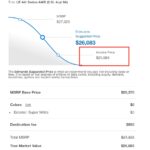Matching your car amplifier to your subwoofers is crucial for optimal sound quality and performance. A mismatch can lead to underpowered subs, distorted sound, or even damage to your equipment. While some factory car audio systems may appear to offer a straightforward setup, understanding the signal path and potential limitations is key to maximizing your audio upgrade. This article explores the importance of signal summing and processing when integrating an aftermarket amplifier, such as the Audiofrog UP10DSP, into a factory system like the Harman Kardon (HK) system found in some BMWs.
Understanding Factory System Limitations
Factory car audio systems, even premium ones like the HK system, often utilize complex signal processing, including equalization (EQ) and crossovers, tailored to the specific factory speakers. While seemingly simple, connecting an aftermarket amplifier directly to the speaker-level outputs of a factory system can introduce unforeseen challenges. The Audiofrog’s default setup file for HK systems, for instance, routes each factory output to a corresponding channel on the UP10DSP without any additional processing. This approach essentially amplifies the pre-processed signal, inheriting any factory EQ curves and crossover points.
The Importance of Signal Summing
The key to unlocking the full potential of an aftermarket amplifier lies in understanding how to achieve a full-range signal. Factory systems often split the audio signal into multiple frequency bands, sending different ranges to different speakers. For example, the front door speakers might handle midrange and high frequencies, while under-seat woofers handle lower frequencies. To properly utilize the UP10DSP’s processing capabilities, these separated frequency bands need to be recombined into a full-range signal. This process, called signal summing, allows the DSP to apply its own EQ, crossovers, and time alignment without being constrained by the factory settings.
Optimizing Your System with Summing
By summing the appropriate channels—for instance, combining the front door speaker output with the under-seat woofer output—a full-range signal is created for each channel of the UP10DSP. This empowers you to implement custom crossovers, tailoring the frequency response to your specific subwoofers and achieving a more balanced and accurate sound. Furthermore, utilizing the full capabilities of the DSP allows for precise time alignment, creating a more cohesive soundstage. Without summing, the DSP is merely amplifying a pre-processed signal, potentially limiting its ability to optimize the sound for aftermarket subwoofers. This meticulous approach to signal management ensures that your subwoofers receive a clean, powerful, and accurately tuned signal, maximizing their performance and longevity.
Achieving a Perfect Match
While the provided setup files offer a starting point, achieving a truly optimized system often requires a deeper understanding of your car’s audio architecture and the specific characteristics of your chosen components. Analyzing the frequency response of the factory outputs can provide valuable insights into the extent of factory EQ and inform your summing and processing decisions. By understanding the importance of signal summing and leveraging the processing power of a DSP, you can create a perfectly matched system where your amplifier and subwoofers work in harmony, delivering a rich and immersive listening experience.


